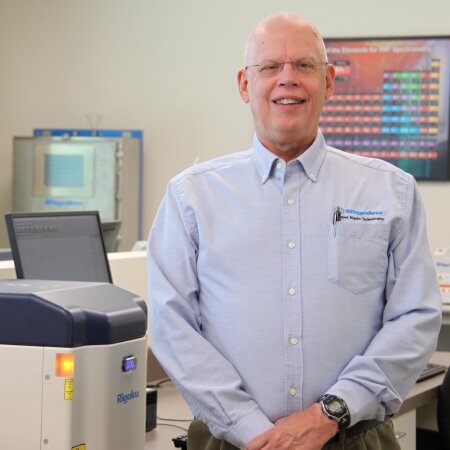Application Note EDXRF3150

Scope
The analysis of black mass powder is demonstrated using NEX QC+ QuantEZ, which features Rigaku RPF-SQX Fundamental Parameters (FP) for semi-quant standardless screening and user-defined Matching Library to optimize accuracy.
Background
Lithium batteries have many uses, from regular batteries to cell phones, tablets, computers, and electric vehicles. At end-of-life, the batteries can be recycled to ensure a sustainable, environmentally friendly use of the raw materials. The devices are collected, disassembled, and the batteries are then shredded and ground. During the process, the plastics are separated and removed leaving a powder called black mass, rich in the cathode metals Co, Mn and Ni, base metals Cu, Fe and Al, as well as the graphite from the anode.
Recovering and repurposing the metals reduces the need to mine fresh raw materials and allows for a sustainable circular economy in the lithium battery industry. Rigaku offers the NEX QC+ QuantEZ EDXRF analyzer for the analysis of black mass during the recycling and recovery of the raw materials to make new, fresh batteries.
Rigaku RPF-SQX fundamental parameters (FP)
Rigaku RPF-SQX FP software estimates elemental concentration based on XRF theory called Fundamental Parameters (FP). Rigaku Profile Fitting (RPF) automatically deconvolutes spectral peaks and models the sample matrix using fundamental XRF equations to provide semi-quantitative measurements of elemental concentrations without the need for any known standards.
Results: FP standardless semi-quant for screening
In this example the semi-quant analysis of a typical black mass sample is shown. The method set-up is based on the FP Powder template adjusted for black mass with the balance of the material defined as graphite. Standardless FP is excellent for screening to measure the overall elemental composition of the black mass.
Typical black mass sample
| Element | Result (mass%) | Stat. error |
| Co | 13.556 | 0.008 |
| Mn | 9.963 | 0.008 |
| Ni | 16.163 | 0.008 |
| Al | 6.156 | 0.009 |
| Cu | 6.605 | 0.009 |
| Fe | 2.104 | 0.003 |
| Si | 0.7577 | 0.0020 |
| P | 2.099 | 0.002 |
| S | 0.1275 | 0.0004 |
| Cl | 0.0317 | 0.0002 |
| K | 0.2074 | 0.0067 |
| Ca | 0.4066 | 0.0050 |
| Ti | 0.4774 | 0.0030 |
| V | 0.0527 | 0.0012 |
| Cr | 0.0382 | 0.0008 |
| Zn | 0.3678 | 0.0013 |
| As | 0.0028 | 0.0002 |
| Zr | 0.1358 | 0.0003 |
| Ag | 0.0026 | 0.0001 |
| Cd | 0.1214 | 0.0004 |
| Sn | 0.0766 | 0.0003 |
| Sb | 0.0256 | 0.0003 |
| Ba | 0.0248 | 0.0006 |
| Pb | 0.0528 | 0.0005 |
Rigaku user-defined matching library
The user can easily tune the semi-quant results using a Matching Library by measuring one or more samples of the material with known elemental assay values. In this way, the XRF is tuned specifically to the black mass and referee values to ensure optimum accuracy and reliable, high-quality data without the need for a large set of assayed standards for calibration.
Results: Rigaku FP with matching library for improved accuracy
In this example the semi-quant accuracy is improved using a 2-point Matching Library for the main metals Co, Mn, Ni, Al, Cu and Fe. Accuracy can be further improved by simply adding a few more samples with ICP numbers to the Matching Library.
Typical Black Mass Sample
| Element | ICP value (mass%) | NEX QC+ QuantEZ result Semi-quant Screening (mass%) | NEX QC+ QuantEZ result using Matching Library (mass%) |
| Co | 11.94 | 13.56 | 12.16 |
| Mn | 8.87 | 9.96 | 8.47 |
| Ni | 14.58 | 16.16 | 14.09 |
| Al | 5.28 | 6.16 | 4.63 |
| Cu | 7.30 | 6.61 | 7.53 |
| Fe | 1.34 | 2.10 | 1.49 |
Conclusion
The Rigaku NEX QC+ QuantEZ offers excellent performance for the elemental analysis of black mass. The powerful combination of Rigaku RPF- SQX FP and Matching Library yields accurate and reliable results, making NEX QC+ QuantEZ an excellent tool for the elemental identification, screening, and characterization of black mass during the recycling process.

